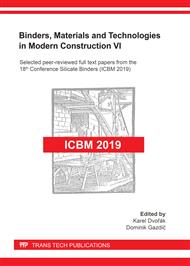p.83
p.89
p.97
p.105
p.113
p.119
p.125
p.131
p.141
Experimental Study of Selected Properties of Heavyweight Concrete Based on Analysis of Chemical Composition and Radioactive Elements of its Components
Abstract:
Heavyweight concrete is mostly used for its shielding properties in the nuclear power plants. These properties can already be influenced by the selection of the input materials. In the present study, concrete samples comprised of four-component binders based on CEM I 42.5 R, blast furnace slag, metakaolin and limestone and a mixture of barite and magnetite aggregate, were investigated. Based on Energy Dispersive X-ray Fluorescence, Neutron Activation, and Prompt-Gamma Activation analyses, three concrete designs were prepared and tested. Mechanical, physical (namely cubic compressive strength, bulk density, longitudinal deformation, and dynamic modulus of elasticity) and thermal properties (thermal conductivity coefficient, specific heat capacity, and thermal diffusivity), which should be influenced by the long-term exposure to irradiation were investigated. Presented results confirmed that the prepared samples are heavyweight concrete with bulk density higher than 3400 kg.m-3 with a low level of longitudinal deformation (between 0.265 ‰ and 0.352 ‰). All the prepared samples belong to the C 35/45 concrete strength class.
Info:
Periodical:
Pages:
113-118
Citation:
Online since:
July 2021
Price:
Сopyright:
© 2021 Trans Tech Publications Ltd. All Rights Reserved
Share:
Citation:


